Non-Linear Conductivity Epoxy/SiC Composites for Emerging Power Module Packaging: Fabrication, Characterization and Application
Abstract
:1. Introduction
2. Materials and Methods
2.1. Sample Preparation
2.2. Characterization Measurement
2.3. Conductivity Measurement
3. Results and Discussion
3.1. Characterization Analysis
3.2. Effects of Crystal Morphology
3.3. Effects of Temperature
3.4. Discussion
4. Application
5. Conclusions
- The non-linear conductivity of the epoxy/β-SiC composite is significantly greater than that of the epoxy/α-SiC composite as the electric field reaches the threshold field.
- The non-linear conductivity of the composites rapidly rises with the rising temperature under the condition of a low α-SiC content. However, when the filler content reaches a certain high level, the non-linear conductivity decreases slightly with the enhancement of temperature.
- The epoxy/SiC composites with non-linear conductivity were applied for module packaging using COMSOL Multiphysics. A uniform electric field distribution was obtained, especially at the triple point, and the maximum electric field reduced from 24.4 to 10.2 kV/mm.
Author Contributions
Funding
Conflicts of Interest
References
- Singha, S.; Thomas, M.J. Dielectric Properties of Epoxy-Al2O3 Nanocomposite System for Packaging Applications. IEEE Trans. Compon. Pack. Technol. 2010, 33, 373–385. [Google Scholar] [CrossRef]
- Jang, K.S.; Eom, Y.S. Crosslinkable deoxidizing hybrid adhesive of epoxy-diacid for electrical interconnections in semiconductor packaging. Polym. Int. 2018, 67, 1241–1247. [Google Scholar] [CrossRef]
- Liu, G.; Xu, F. Assembly HVDC Breaker for HVDC Grids with Modular Multilevel Converters. IEEE Trans. Power Electron. 2017, 32, 931–941. [Google Scholar] [CrossRef]
- Tousi, M.M.; Ghassemi, M. Combined Geometrical Techniques and Applying Nonlinear Field Dependent Conductivity Layers to Address the High Electric Field Stress Issue in High Voltage High-Density Wide Bandgap Power Modules. IEEE Trans. Dielectr. Electr. Insul. 2020, 27, 305–313. [Google Scholar] [CrossRef]
- Li, J.; Zhang, C. Electrical Field Simulation of Epoxy Spacer with Nonlinear Conductivity for DC GIL. High Volt. Eng. 2019, 45, 1056–1063. [Google Scholar]
- Liu, C.; Zheng, X. Research of Preparation and Non-Linear Conductivity Modification of Doped ZnO/Epoxide Resin Material. Trans. China Electrotech. Soc. 2016, 31, 24–30. [Google Scholar]
- Hu, J.; Zhao, X. Improving the Electric Field Strength Distribution of Cable Terminals by Stress Cone of Nonlinear Conductivity Material. High Volt. Eng. 2017, 43, 398–404. [Google Scholar]
- Donzel, L.; Greuter, F. Nonlinear resistive electric field grading, part 2: Materials and applications. IEEE Electr. Insul. Mag. 2011, 27, 18–29. [Google Scholar] [CrossRef]
- Li, J.; Du, B.X. Nonlinear Conductivity and Interface Charge Behaviors between LDPE and EPDM/SiC Composite for HVDC Cable Accessory. IEEE Trans. Dielectr. Electr. Insul. 2017, 24, 1566–1573. [Google Scholar] [CrossRef]
- Du, B.X.; Yang, Z.R. Surface charge behavior of silicone rubber/SiC composites with field-dependent conductivity. IEEE Trns. Dielectr. Electr. Insul. 2017, 24, 1340–1348. [Google Scholar] [CrossRef]
- Donnelly, K.P.; Varlow, B.R. Non-Linear DC and AC conductivity in electrically insulating composites. IEEE Trans. Dielectr. Electr. Insul. 2003, 10, 610–614. [Google Scholar] [CrossRef]
- Xie, J.C.; Hu, J. Effect of silicone rubber polymer composites on nonuniform electric fields of rod-plane gaps. In Proceedings of the 2013 IEEE Conference on Electrical Insulation and Dielectric Phenomena, Shenzhen, China, 20–23 October 2013; pp. 399–402. [Google Scholar]
- Wang, X.; Nelson, J.K. Mechanisms Leading to Nonlinear Electrical Response of a Nano p-SiC/Silicone Rubber Composite. IEEE Trans. Dielectr. Electr. Insul. 2010, 17, 1687–1696. [Google Scholar] [CrossRef]
- Wang, Z.P.; Nelson, J.K. Graphene Oxide Filled Nanocomposite with Novel Electrical and Dielectric Properties. Adv. Mater. 2012, 24, 3134–3137. [Google Scholar] [CrossRef]
- Imai, T.; Sawa, F. Influence of Temperature on Mechanical and Insulation Properties of Epoxy-Layered Silicate Nanocomposite. IEEE Trans. Dielectr. Electr. Insul. 2006, 13, 445–452. [Google Scholar] [CrossRef]
- Maryam, T.; Mona, G. Effects of Frequency and Temperature on Electric Field Mitigation Method via Protruding Substrate Combined with Applying Nonlinear FDC Layer in Wide Bandgap Power Modules. Energies 2020, 13, 2022. [Google Scholar]
- Marc, J. HVDC, The Next Generation of Transmission: Highlights with Focus on Extruded Cable Systems. IEEE Trans. Electr. Electron. Eng. 2010, 5, 400–404. [Google Scholar]
- Wang, F.F.; Zhang, P.H.; Gao, M.Z. Research on the Non-linear Conductivity Characteristics of Nano-SiC Silicone Rubber Composites. In Proceedings of the 2013 IEEE Conference on Electrical Insulation and Dielectric Phenomena, Shenzhen, China, 20–23 October 2013; pp. 535–538. [Google Scholar]
- Li, Z.L.; Du, B.X. Effects of Crystal Morphology on Space Charge Transportation and Dissipation of SiC/Silicone Rubber Composites. IEEE Trans. Dielectr. Electr. Insul. 2017, 24, 2616–2625. [Google Scholar] [CrossRef]
- Liang, H.C.; Du, B.X. Effects of Non-linear Conductivity on Charge Trapping and De-trapping Behaviours in Epoxy/SiC Composites under DC Stress. IET Sci. Meas. Technol. 2018, 12, 83–89. [Google Scholar]
- He, E.G.; Chen, S.T.; Wang, X.G. Different Nonlinear Conduction Mechanism Between α-Sic and β-Sic. In Proceedings of the IEEE International Conference on Properties and Applications of Dielectric Materials (ICPADM), Xi’an, China, 21–26 June 2000; pp. 922–925. [Google Scholar]
- Liu, C.Y.; Zheng, Y. Review of Nonlinear Conductivity Theory Research of Modified Composite Materials. IEEE Access 2019, 7, 50536–50548. [Google Scholar] [CrossRef]
- Du, B.X.; Yang, Z.Y. Temperature-Dependent Nonlinear Conductivity and Carrier Mobility of Silicone Rubber/SiC Composites. IEEE Trans. Dielectr. Electr. Insul. 2018, 25, 1080–1087. [Google Scholar] [CrossRef]
- Teng, C.Y.; Zhou, Y.X. Regulation of Temperature Resistivity Characteristics of Insulating Epoxy Composite by Incorporating Positive Temperature Coefficient Material. IEEE Trns. Dielectr. Electr. Insul. 2020, 27, 512–520. [Google Scholar] [CrossRef]
- Tousi, M.M.; Ghassemi, M. Nonlinear Field Dependent Conductivity Materials for Electric Field Control within Next-Generation Wide Bandgap Power Electronics Modules. In Proceedings of the Electrical Insulation Conference (EIC), Calgary, AB, Canada, 16–19 June 2019; pp. 63–66. [Google Scholar]
- Tousi, M.M.; Ghassemi, M. Electric Field Control by Nonlinear Field Dependent Conductivity Dielectrics Characterization for High Voltage Power Module Packaging. In Proceedings of the IEEE International Workshop on Integrated Power Packaging (IWIPP), Toulouse, France, 24–26 April 2019. [Google Scholar]
- Donzel, L.; Schuderer, J. Nonlinear Resistive Electric Field Control for Power Electronic Modules. IEEE Trns. Dielectr. Electr. Insul. 2012, 19, 955–959. [Google Scholar] [CrossRef]
- Reynes, H.; Buttay, C.; Morel, H. Protruding Ceramic Substrates for High Voltage Packaging of Wide Bandgap Semiconductors. In Proceedings of the 5th IEEE Workshop on Wide Bandgap Power Devices and Applications (WiPDA), Albuquerque, NM, USA, 30 October–1 November 2017; pp. 404–410. [Google Scholar]
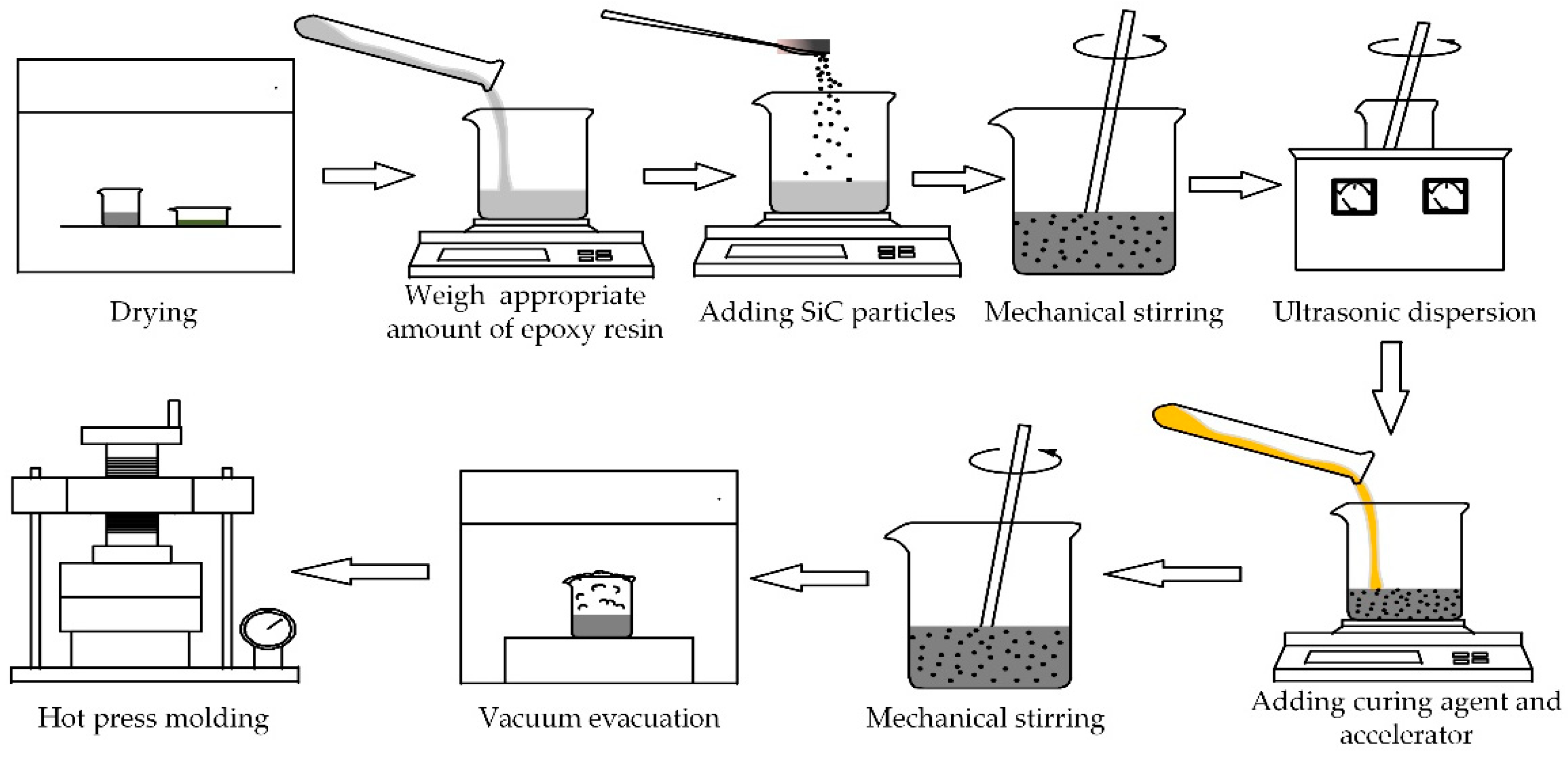

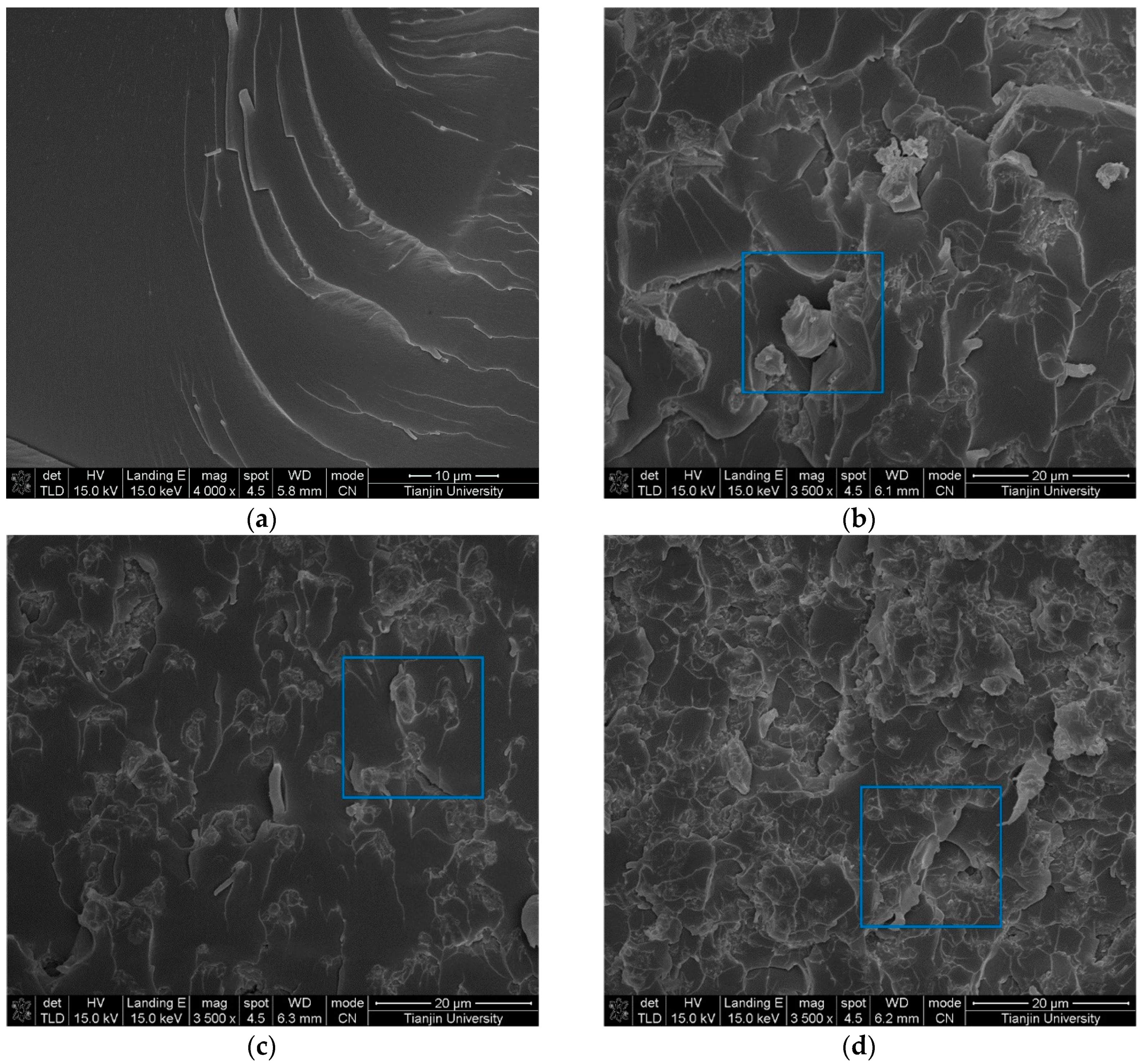
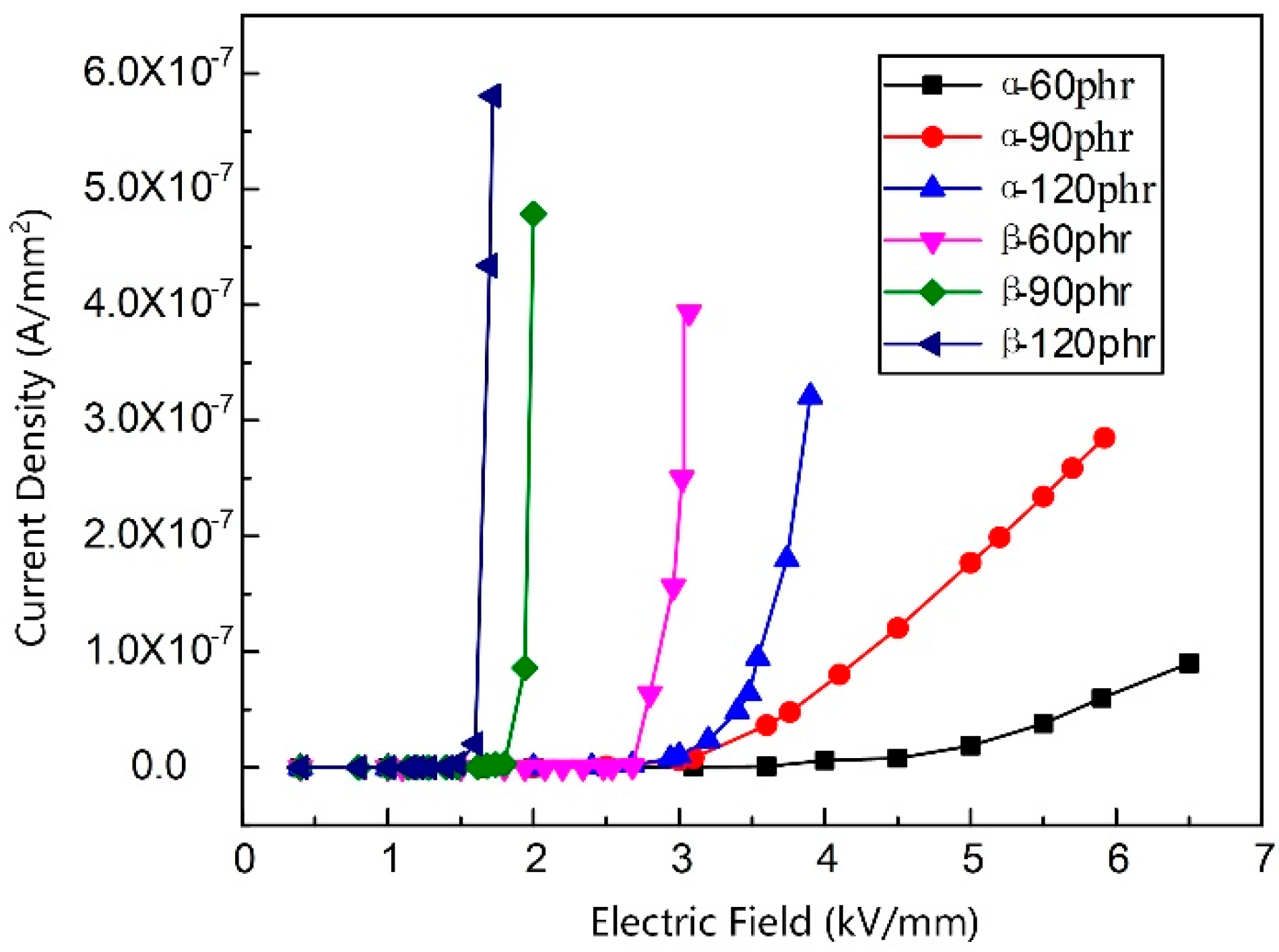
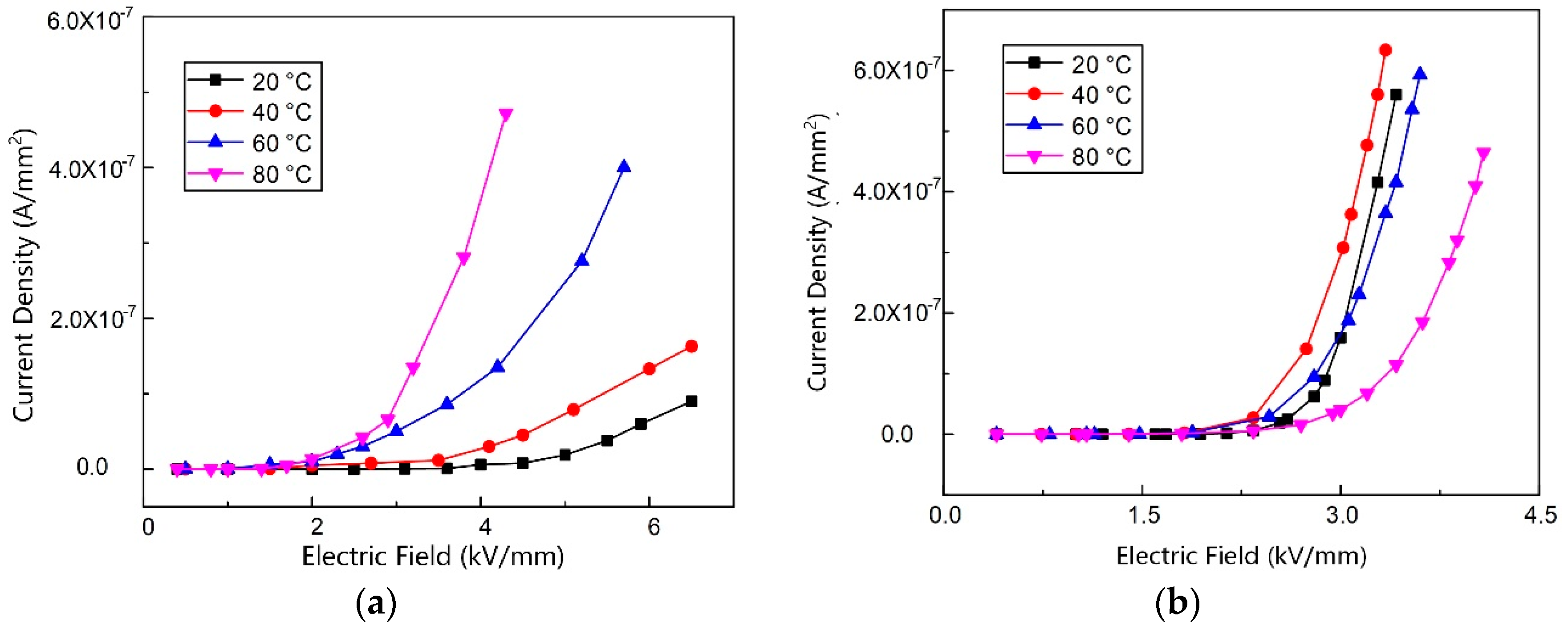
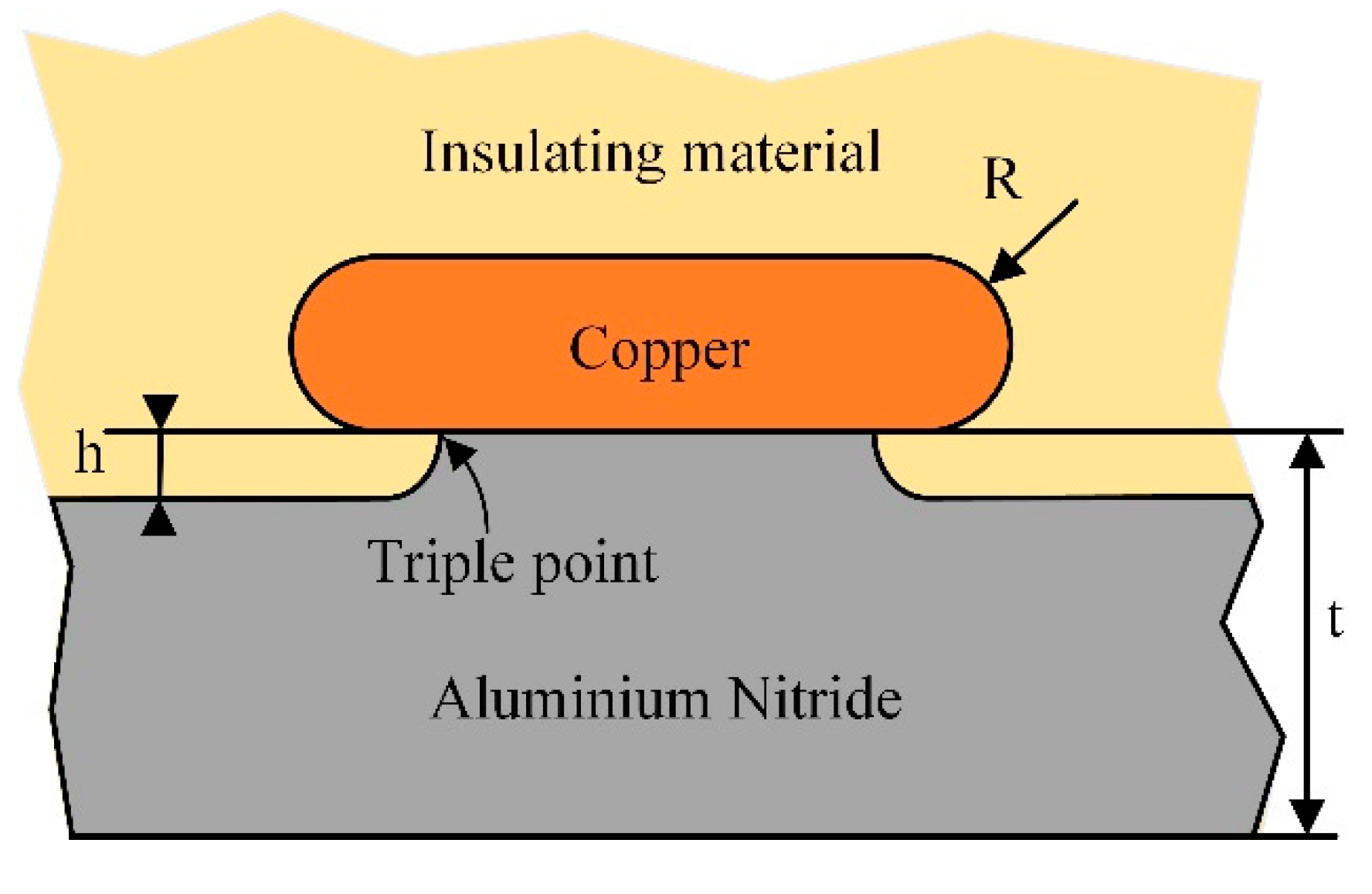
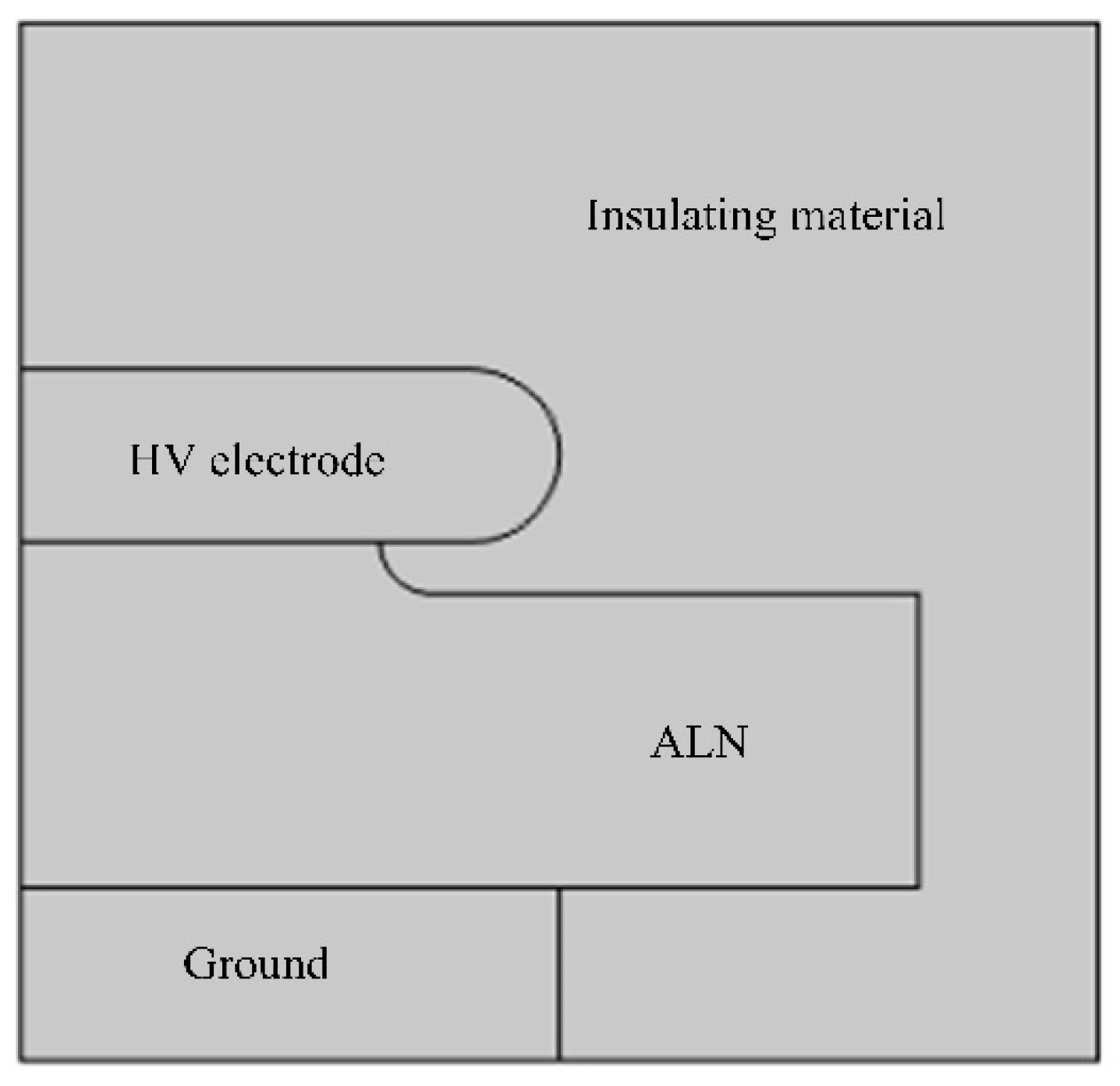

| Item | Index |
|---|---|
| Appearance | Colorless clear liquid |
| Color (number) | ≤ 2 |
| Density (g/mL, 25 °C) | 1.02–1.11 |
| Viscosity (MPa, 25 °C) | 100–500 |
| Epoxide equivalent (g/eq) | 178–195 |
| Shear strength | ≥10 |
| Item | Index |
|---|---|
| Appearance Density (kg/m3) | Light yellow viscous liquid 0.99 |
| Viscosity (mPa·s, 25 °C) Amine value (mg KOH/g) | 200–1000 400 |
| SiC Content (phr) | 60 | 90 | 120 | 150 |
|---|---|---|---|---|
| wt% | 37.50 | 47.37 | 54.55 | 60.00 |
| vol% | 18.22 | 25.05 | 30.82 | 35.78 |
| α-SiC | 60 | 90 | 120 |
|---|---|---|---|
| k | 3.12 | 5.56 | 11.55 |
| Eb (kV/mm) | 4.32 | 3.36 | 3.15 |
| β-SiC | 60 | 90 | 120 |
|---|---|---|---|
| k | 30.22 | 44.76 | 45.28 |
| Eb (kV/mm) | 2.83 | 1.96 | 1.64 |
| Temperature (°C) | 20 | 40 | 60 | 80 |
|---|---|---|---|---|
| k | 3.12 | 3.66 | 3.56 | 4.67 |
| Eb (kV/mm) | 4.32 | 3.50 | 3.28 | 2.66 |
| Temperature (°C) | 20 | 40 | 60 | 80 |
|---|---|---|---|---|
| k | 11.73 | 8.84 | 7.91 | 7.95 |
| Eb (kV/mm) | 2.67 | 2.55 | 2.83 | 3.02 |
| Material | Relative Permittivity | Conductivity σ (S/m) |
|---|---|---|
| Ceramic substrate | 9 | 10−11 |
| Neat epoxy material Epoxy/SiC Composite | 3.6 10 | 10−15 σ(E) |
© 2020 by the authors. Licensee MDPI, Basel, Switzerland. This article is an open access article distributed under the terms and conditions of the Creative Commons Attribution (CC BY) license (http://creativecommons.org/licenses/by/4.0/).
Share and Cite
Li, R.; Wang, Y.; Zhang, C.; Liang, H.; Li, J.; Du, B. Non-Linear Conductivity Epoxy/SiC Composites for Emerging Power Module Packaging: Fabrication, Characterization and Application. Materials 2020, 13, 3278. https://doi.org/10.3390/ma13153278
Li R, Wang Y, Zhang C, Liang H, Li J, Du B. Non-Linear Conductivity Epoxy/SiC Composites for Emerging Power Module Packaging: Fabrication, Characterization and Application. Materials. 2020; 13(15):3278. https://doi.org/10.3390/ma13153278
Chicago/Turabian StyleLi, Rui, Yufan Wang, Cheng Zhang, Hucheng Liang, Jin Li, and Boxue Du. 2020. "Non-Linear Conductivity Epoxy/SiC Composites for Emerging Power Module Packaging: Fabrication, Characterization and Application" Materials 13, no. 15: 3278. https://doi.org/10.3390/ma13153278
APA StyleLi, R., Wang, Y., Zhang, C., Liang, H., Li, J., & Du, B. (2020). Non-Linear Conductivity Epoxy/SiC Composites for Emerging Power Module Packaging: Fabrication, Characterization and Application. Materials, 13(15), 3278. https://doi.org/10.3390/ma13153278






